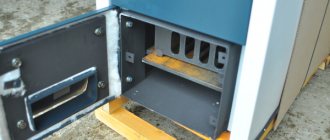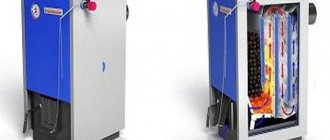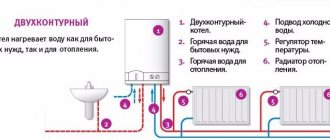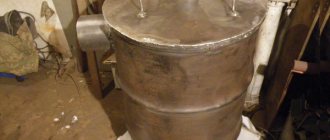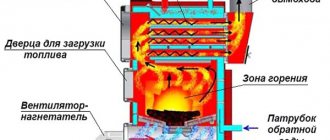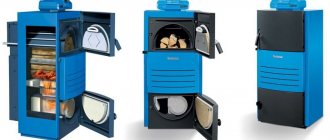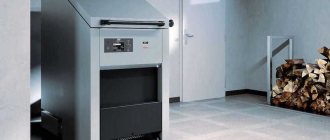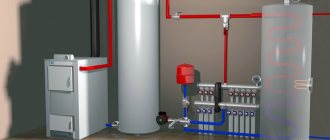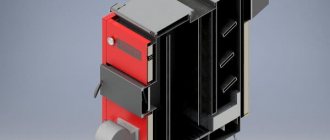Operating principle of a long-burning boiler
Solid fuel boilers appeared relatively long ago, but all of them, regardless of model and manufacturer, had one significant drawback.
Fuel had to be constantly added as it burned. It was ineffective and not economical. This situation continued exactly until 2000, until the Stropuva company found a way to eliminate this problem. It is to engineer Edmuntas Štropaitis that we owe the invention of the long-burning boiler. Today, this is the most practical and functional device for heating a private home or cottage, the performance level of which reaches 70 and sometimes 100%. But, unlike classic pyrolysis boilers, which are also characterized by good efficiency, such units can maintain heat for 7 days with just one batch of fuel!
What are its main technical features and what makes this device so economical and effective?
Long-burning boiler design
The operating principle of a long-burning solid fuel boiler is similar to pyrolysis units. The main heat is generated not from the combustion of wood or coal, but from the gasification of solid fuel. The combustion process takes place in a closed space, from where wood gas is released through a special telescopic pipe.
After this, the gas is directed into the heater nozzle, where diffusion (mixing) occurs with secondary air pumped by the fan. Thus, a continuous process will occur until the coals or firewood are completely burned. In this case, the combustion temperature sometimes reaches 1200 degrees.
Internal structure of a long-burning boiler
The effectiveness of this principle lies precisely in the fact that solid fuel is consumed very slowly, as needed, which significantly increases the efficiency of such a heating device. But not only high performance is the advantage of this design.
As a rule, the whole point of long-lasting combustion is that not the entire load of coal or firewood burns out at the same time, but only the top layer. Due to the fact that air is supplied from above and not from below, fuel burnout occurs gradually, in its upper layer.
Long burning principle
When this layer burns out, the air supply is turned on, and exactly as much as is needed to burn the top layer. This ensures such a burning duration and the ability to control the process.
It should be said that this version of the heating device is acceptable exclusively as a heating system. If you need to think about a water heating system for domestic needs, then you should look for other options.
If the option is selected specifically for heating a large house, then such a device is an excellent alternative to electric and gas appliances.
Types of solid fuel boilers
Currently, there are many types of different heating boilers and the fuel for them is completely different, but traditional types of fuel such as coal and firewood still remain the most common. When buying a modern boiler, many people are intimidated by the fact that it needs to be constantly monitored and fuel added. This problem has been solved; special solid fuel boilers have been created that operate for a long time without human intervention.
- The first type of boiler is called cast iron. It is designed to burn fuels such as coal and wood. Despite all its positive aspects, it is still dependent on people and energy supply. Wood in such a boiler usually burns for no more than 5 hours, which means fuel must be constantly added. Currently, domestic and foreign manufacturers produce such boilers, some of them are called KChM and Solida.
- The second type differs in many ways from the first and is called pyrolysis heating boilers. There are two combustion chambers, in one of which the fuel immersed in the boiler burns, and in the second the gas synthesis burns out. The main type of fuel is wood. It has a longer burning time than a cast iron boiler; here it is 10 hours. One of the most successful boilers of this type is called Dakon, made in the Czech Republic.
- Pellet boilers, the name comes from the word pellets (granulated wood). It is she who needs to heat the room using such boilers. It has a convenient additional advantage - it independently adds the required amount of fuel using an auger and ignites it. The burning time in this case depends on the boiler model and the capacity of its hopper. But there is also a significant drawback - you cannot burn anything except wood pellets in such a boiler.
- The most modern and popular type is long-burning boilers. Firewood, sawdust, coal, and peat can be used as fuel. They surpass their analogues in combustion time; with such a boiler no human intervention is needed for 2 days or more thanks to the latest top-down combustion system, this allows the fuel not to burn, but to smolder for a long time.
Solid fuel boilers are a good alternative to gas. If you live in a country house or your street is not gasified, a long-burning boiler using coal, wood and other fuels will perfectly heat a room of any size.
How to choose a solid fuel boiler
When choosing a boiler, you should pay attention to the following criteria:
- boiler design;
- principle of operation;
- power;
- type of raw materials used;
First of all, you should pay special attention to power. This is one of the most important criteria and the operation of the boiler depends on it, since not every model can cope with a home heating system that is too large. You need to check the power of the boiler with a specialist; he will compare criteria such as the area of the house, the climatic region and even the height of the ceilings. The approximate required power can be calculated independently based on the following rule: 1 kW of power is required for 10 square meters.
An error in choosing the boiler power can have a bad effect on the quality of heating. With a lower degree of heating, the room will be cold, and with a higher degree, the equipment may fail.
Boiler installation location
The ideal place for the boiler is an easily accessible separate room. The best option is a separate room in the house.
This will make loading fuel easy and fun. In the winter season, the desire to leave the house to a separate boiler room, as a rule, disappears immediately. Three important rules when choosing a boiler installation location:
- Ventilated room. If additional gas is used as fuel, a slight leak may occur. If the installation is done correctly, there is no need to be afraid of leaks, but if they accumulate for a long time, there is a high probability of poisoning.
- Deep cellar. Not the easiest option for installing a boiler, but still, if the house has the opportunity to install it at a depth of 2 - 3 meters from the heating radiator, this would be an ideal option. Thanks to this installation, no additional circulation is needed, you don’t need to use circulation pumps, but if the installation option is only in the house, circulation is required, if it is missing or installed incorrectly, carbon monoxide can leak, it is impossible to determine its presence in the room without special devices, and you can be poisoned by it easily.
- Chimney. It is important to provide the necessary traction. If these calculations are incorrect, the boiler power may be reduced and combustion products may enter the room. The installation of the chimney must be carried out by a specialist, since it is easy to make a mistake in this difficult task and lose heat.
If all rules are followed, the solid fuel boiler will work properly for many years.
To remove polluting particles from heating systems, it is necessary to install a smoke exhauster. Details:
What are modern boilers equipped with?
Most models of domestic and foreign manufacturers are equipped with thermal insulation, which helps reduce heat loss. In such boilers, a control unit equipped with a fan often replaces an automatic draft regulator.
To adjust the combustion intensity, you can select an automatic or manual air supply regulator to the combustion chamber. Low-power boilers with manual adjustment are convenient to use because they allow you to adjust the draft in accordance with the selected temperature regime.
Double-circuit solid fuel boilers are also in great demand, performing two functions simultaneously: heating the premises of the house and providing its residents with hot water. When choosing a device, it is worth determining for yourself whether it will be the main or auxiliary element of the system.
Scheme: operation of a solid fuel boiler
If you focus on the cost of a solid fuel boiler, then it is better to give preference to units from foreign manufacturers in the middle price segment. The only significant difference from expensive analogues will be the absence of complex electronics.
Its main task is to control the combustion process taking into account the temperature of the interior and exterior air, thereby simplifying the operation of the unit.
Boiler with automatic coal supply
An automatic coal boiler differs from a traditional one in that it contains additional devices. Automatic devices do not require the constant presence of the owner nearby, increase system performance and minimize fuel consumption and the amount of remaining ash.
Automation functions:
- It controls the supply of coal to the combustion chamber. The design involves a filling hopper with an auger (or drum) for automatic fuel supply. However, the user only needs to replenish the fuel supply in the bunker once every few days (from three to ten).
- Monitors the air supply to the combustion zone. Optimal supply and initial heating of air also contribute to the uniform combustion of coal and the efficiency of equipment operation. A coal boiler with automatic fuel supply has an efficiency factor of 90% (this is more compared to other types of designs: a conventional boiler - 70%).
- Automatically dumps ash with movable grates.
The operating principle of a pellet boiler with auto-loading is presented here
The device’s auto operating mode is adjusted by parameters set by the owner. In accordance with the temperature values for heating water and heating indoors, the automation activates combustion or maintains smoldering mode for up to five days. Thanks to continuous combustion, ignition can be carried out powerfully once per heating season.
The principle of automatic fuel supply to a solid fuel boiler
The operating principle of the automation is not complicated. Depending on the degree inside the boiler equipment, liquid capacity, pressure force, commands are sent to the air supply sensor. If the air speed increases or the supply decreases, combustion increases or, accordingly, weakens. This also adjusts the heating temperature of the water inside the heat exchanger.
Electricity is required to operate a coal-fired automatic boiler, which is why such units are classified as energy-dependent. They need the presence of a network (battery, outlet).
Coal-fired equipment is 20-40% more expensive than wood-burning units. But built-in automation makes it possible to reduce heating costs. According to user reviews, fuel savings can sometimes reach 50%. Thus, it can be argued that heating with coal is one of the most profitable for private residential buildings, workshops, workshops...
Rating of combined boilers
A large number of different models sometimes causes difficulty in choosing even for specialists, not to mention ordinary buyers, so we publish the top 5 models. For clarity, let's summarize the data in a table.
Table 1. The best models of 2018-2019
| Model | Fuel types | Description | power, kWt | Efficiency,% | Weight, kg |
| ZOTA MIX-20 | Coal, firewood, gas, diesel fuel electricity | A model from a Russian manufacturer that consumes basic types of fuel without problems. Withstands short-term pressure increases up to 4 atm (working 3 atm). The material of the heating elements is a seamless stainless steel tube. Their operation is controlled by an external control panel. The device is also equipped with a draft regulator and a thermomanometer, which increases the efficiency of the combustion process. To protect against heat loss, the water jacket is insulated. Wear resistance of the outer casing is achieved thanks to powder paint coating. | 3-9 | 80 | 140 |
| KARAKAN 16TPEV 3 | Firewood, gas, electricity | The dual-circuit model of the Russian manufacturer is especially popular among rural residents, because It is equipped with a wide hob on which you can cook food for yourself and your livestock. The unit can easily heat an area of up to 160 sq.m., this applies not only to residential, but also to industrial premises, incl. greenhouse or garage. The depth of the steel firebox is 0.56 m. The “water jacket” prevents the metal from overheating or burning out, which makes the device’s service life long. | 9 | 75 | 120 |
| Teplodar Cupper PRO 22 | Firewood, coal, gas, pellets | The domestic model can easily heat rooms up to 220 sq.m. When using firewood or coal, the unit acquires the features of a long-burning boiler, since on one tab the operating period is 8 and 10 hours, respectively. Another plus is the spacious firebox, which can accommodate firewood up to 600 mm long. | 6 | 80 | 115 |
| Kiturami KRM 30R | Firewood, briquettes, coal, diesel. | The double-circuit boiler from South Korea is equipped with several combustion chambers and electronic control. Capable of heating a room up to 350 sq.m. The heat exchangers are made of alloy steel, so you should not increase the pressure too much. | 35 | 85-92 | 170 |
| Protherm Bison 40 NL | Gas, diesel, fuel oil | The double-circuit model from Slovakia is capable of heating areas up to 400 sq.m. The control is carried out using a microprocessor, and the electronic display clearly shows the operating parameters of the boiler at any given time. | 38 | 89 | 148 |
Appearance of the Protherm Bizon 40 NL boiler
Operating principle of the equipment
The working process is based on the combustion of fuel in the corresponding chamber
It is important to note that different materials can be used as fuel. For example, for a combination boiler, wood and coal are not the only energy sources
Such models can accept briquettes, pellets, husks and shavings. But for this it is necessary that the design of the chamber be oriented towards working with other types of solid fuel.
Regardless of the type of raw material consumed, the firebox releases thermal energy, which can be directly converted into hot air flows, or go into a heat exchanger to heat water. If a coal-fired boiler is used, the combustion process will be long and the thermal energy potential will be high. In contrast, low-density dry firewood or briquettes with chips burn quickly, leaving little heat but a lot of ash and ash.
Gas and electric boiler
An electric heating boiler is not inferior to a solid fuel one; in some cases, installing an electric boiler will be a better choice. Such a case is the frequent absence of owners. You can leave the house for the whole winter, leaving a small boiler power to maintain the temperature, but you will need to have an additional electric generator. It is necessary to add fuel to a solid fuel boiler after a certain period of time. An electric boiler also has a lot of disadvantages, for example: the price of electricity, wiring power, water hardness in the water supply must be certain, etc.
The gas boiler is practical, easy to use and unpretentious in operation. Its performance can only be disrupted by a breakdown or gas shutdown, which usually occurs solely at the request of the owners. Gas boilers do not require much space and can operate on two types of fuel. If there is no space in the house to install a solid fuel boiler, you can install a gas boiler.
Despite the advantages of other boilers, they cannot be compared with solid fuel coal boilers. And their most important advantage is environmentally friendly raw materials for heating the premises.
Automatic boilers
Long-burning automatic coal boilers offered on the modern market are designed on the principle of pellet installations. Their feature is the presence of a burner device and a bunker for loading fuel reserves. The design of the heat exchange part of the units repeats the design of their traditional “brothers”; a fire tube heat exchanger or other multi-pass design is used to transfer heat.
The main feature is the retort type burner. It consists of a bowl - a retort, a feed auger with a gearbox and an electric motor, and a fan for forcing air. Coal from the hopper will fall into the receiving hole of the feed auger, which moves it into the bowl. The latter has side slots for the flow of air pumped by the fan.
Such a coal-fired boiler is fully automated, from the electric ignition operation to the control of combustion intensity. The operating time of the unit is not limited by the fuel supply, which can be replenished by pouring it into the bunker on the move. Only the frequency of maintenance and cleaning requires stopping the boiler once a week.
A prominent representative of this type of heater is an automatic coal boiler of the Heiztechnik brand, equipped, in addition to the main components, with a circuit for supplying hot water, a circulation pump and a programmable controller with the ability to connect external thermostats. The controller controls the operation of the burner and can stop it at any time, which is a significant advantage for solid fuel units. Another plus is the ability to quickly install a grate, remove the burner and continue working with traditional direct combustion of fuel in the firebox. The efficiency of the unit is declared by the manufacturer at 88%.
The disadvantages of a coal boiler with a screw burner are its high cost and demands on the quality of fuel. The Heiztechnik manufacturer's requirements are as follows:
- fraction size – no higher than 25 mm;
- humidity – up to 10%;
- dust content in fuel – no more than 20%;
- coal for automatic boilers - medium-coking, type 31 or 32, not higher.
Types of coal boilers
All solid fuel boilers are mounted exclusively on the floor.
Based on the type of heat exchanger, it is customary to distinguish between devices with cast iron and steel heat exchangers. Advantages of cast iron boilers compared to steel ones:
- more compact;
- corrosion resistant;
- the design consists of separate, easily replaceable elements.
The main disadvantage of cast iron coal boilers is the fragility of cast iron elements: with sudden temperature changes and impacts, such parts can burst. But in this case, the cost of repairs is significantly reduced due to the elemental design.
Heat generators with a steel heat exchanger are cheaper and easier to repair. You can make a steel boiler yourself in a garage or home workshop.
Advantages of boilers of this type
As mentioned above, a modern coal-fired boiler has much in common with a classic Russian stove. But if a hot brick fireplace directly heats the air in the house, a coal boiler heats water, which then circulates through the radiator system of the heated room.
In all other respects, solid fuel boilers for heating a private house embodied the versatility of their original Russian predecessor. For example, they are unpretentious in the choice of combustible material and allow you to charge firewood, briquettes, pellets, sawdust, paper waste, rags, which in itself is a good idea for recycling combustible waste.
On the other hand, of course, operating a boiler using “frozen” fuel requires more control: you will have to monitor instrument readings and replenish the tank more often. And since such raw materials burn unevenly, temperature changes are possible in the radiator system. Not to mention the fact that garbage that is not used as fuel leaves carbon deposits and soot that need to be cleaned.
Therefore, despite the abundance of waste fuel, prudent (read lazy) owners acquire a large supply of long-burning coal. Using such a heat source, the stove can operate for several days without requiring additional maintenance, cleaning or even refueling.
Unlike a Russian stove, which requires compliance with a certain kindling technology, a coal boiler is extremely easy to use - just open the firebox and throw coal inside
This operation requires a minimum of precautions; the installation and operation features of a coal boiler mean that all potentially dangerous processes are controlled automatically
Another advantage of a coal boiler is its high efficiency, and the use of modern energy-saving technologies has doubled the productivity of new solid fuel boilers compared to old-style coal stoves.
Of course, for a city dweller, spoiled by centralized heating and water supply, the need to load the tank from time to time may seem tedious, but only at first glance. Almost all modern coal-fired boilers make the most of a single load, and temperature control is carried out by sensor systems and air supply devices.
Due to their high efficiency and safety, coal fuel boilers are successfully used for heating cottages and summer houses, residential buildings and offices. But, of course, coal equipment finds ideal use in private residential construction, where its surface can also be used to heat food.
Criteria for selecting long-burning solid fuel boilers
We have already become familiar with the general classification of solid fuel boilers. It's time to consider the criteria by which owners of private houses determine the optimal options for units for installing heating systems. After reading the following sections, you will learn how to choose the right long-burning solid fuel boiler for your home.
Type of fuel
First of all, you must decide what fuel will be used for heating. Based on what type of fuel is more convenient to buy and import. If you have harvested wood, it would be wise to purchase a wood-burning boiler. Owners of cottages where there are no trees can recommend heating with pellets. Coal boilers are suitable for those who have the opportunity to order high-quality fuel on favorable terms. Sawdust heating systems are typically used to heat wood processing facilities.
Boiler power
To determine the required power of the heating system, you need to make simple mathematical calculations. Calculate the total volume of the premises you are going to heat. The resulting figure will help you find a model with the appropriate parameters in a wide range of long-burning solid fuel boilers. Keep in mind: you should always provide a power reserve so that during severe winter frosts the house does not become cold.
Device weight
When choosing a long-burning solid fuel boiler for heating a private home, the mass parameter is taken into account only if the owner intends to mount the purchased unit on the wall. According to state standards established by the Russian gas service, this installation method is allowed for heating boilers with a volume of less than 100 liters
Loading chamber volume
This parameter characterizes the ratio of the volume of fuel supplied to the power of the heating unit. The more fuel that fits in the loading chamber, the less often you will have to replenish the supply of firewood/coal/pellets. For steel boilers, the ratio of these values is 1.6-2.6 l/kW. Cast iron heating units consume fuel in smaller quantities - 1.1-1.4 l/kW.
The total volume of the loading chamber will help you roughly estimate the capabilities of the boiler. In any case, you will not be able to fill it 100%. The usable volume of the loading chamber is much more important. This value reflects the actual amount of fuel that you can load into the combustion chamber. To determine it, you need to know the principle of combustion of the selected boiler and the method of loading fuel (top or front).
Boiler efficiency
One of the most important parameters for any long-term combustion solid fuel heating unit. The figure expressing the efficiency of the boiler characterizes that part of the generated thermal energy that is actually spent on heating the home. By choosing a unit with a high efficiency, you can reduce power requirements. Low efficiency means waste of heat, so you will have to add more fuel to maintain an acceptable temperature in your home.
Pyrolysis systems
Scientists have long noticed that the combustion of any solid fuel releases carbon dioxide, which can be used as additional fuel.
This process is called pyrolysis. When wood burns, quite a lot of such gas is released. That’s why wood-burning pyrolysis boilers have become so widespread. The operating principle of such devices is quite simple. Fuel is placed in the first combustion chamber. With little air supply, the firewood smolders and releases pyrolysis gas. which enters the second chamber. Here the gas is burned and heats the coolant of the home heating system.
This device can significantly increase the efficiency of a wood-burning boiler. The efficiency of such devices reaches 90% and higher. In addition, long-burning pyrolysis boilers have other advantages, namely:
- the fuel burns almost completely. There is no need to constantly remove numerous combustion products;
- The boiler operating time on one charge increases. It is enough to “throw” firewood into the firebox once every 15 hours;
- fuel consumption is significantly reduced, which entails savings on heating the house;
- The devices are environmentally friendly. During the combustion of pyrolysis gas, no harmful substances are released into the atmosphere. When they burn, carbon dioxide and water vapor are produced;
- it becomes possible to completely control the combustion temperature;
- Long-burning pyrolysis wood boilers are unpretentious in maintenance.
But, despite all its advantages, pyrolysis equipment is not without its disadvantages. Among them are the following:
- Pyrolysis boilers are quite expensive equipment. For many families, it may simply not be affordable. But such devices will allow you to save on heating your home, which offsets the cost of purchasing equipment;
- boilers are heavy and have impressive dimensions due to their complex structure;
- quite demanding on fuel quality. The firewood must be dry, the efficiency of the device depends on this;
- the need for a constant supply of electricity. The device contains blower fans that require electricity.
The high cost of long-burning pyrolysis heating boilers significantly reduces their popularity. But many craftsmen make such devices themselves. Schemes and drawings can be easily found on the Internet.
